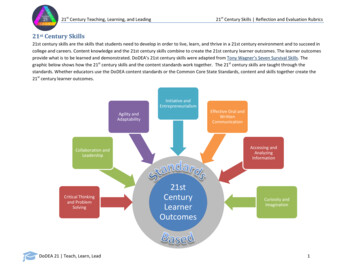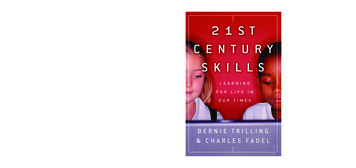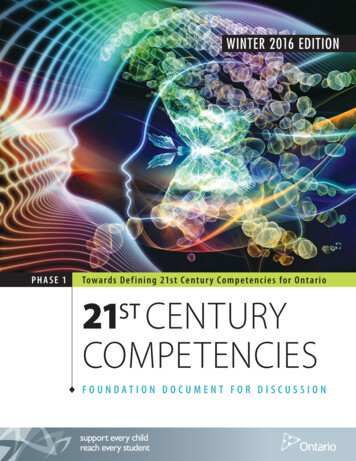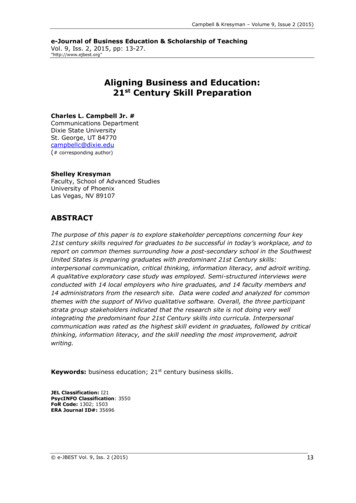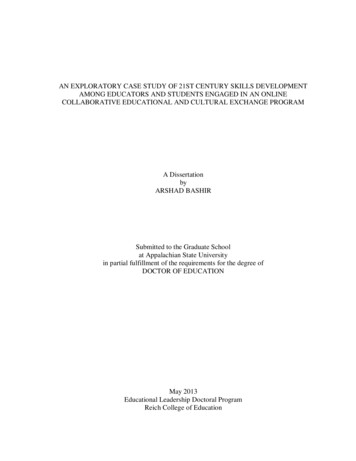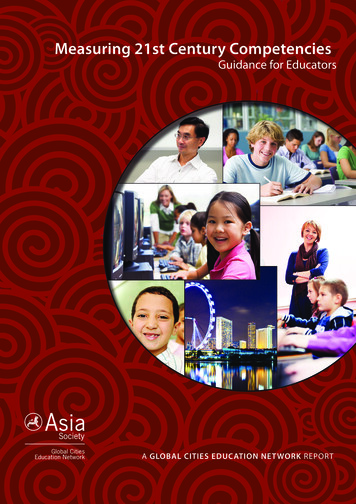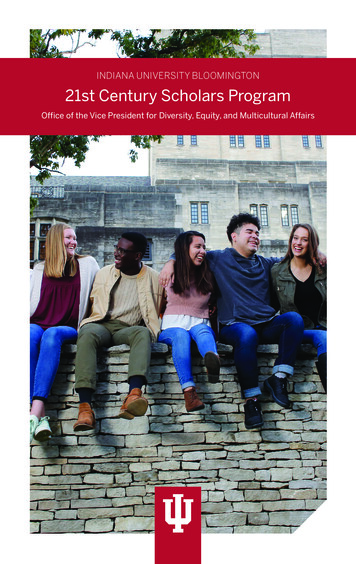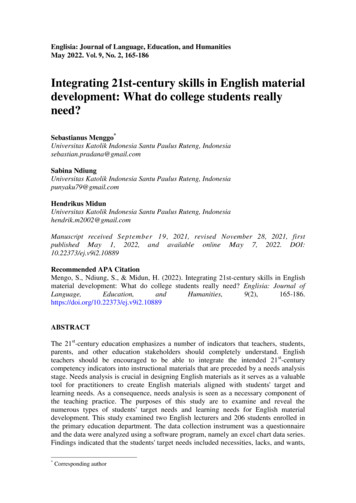
Transcription
Englisia: Journal of Language, Education, and HumanitiesMay 2022. Vol. 9, No. 2, 165-186Integrating 21st-century skills in English materialdevelopment: What do college students reallyneed?Sebastianus Menggo*Universitas Katolik Indonesia Santu Paulus Ruteng, Indonesiasebastian.pradana@gmail.comSabina NdiungUniversitas Katolik Indonesia Santu Paulus Ruteng, Indonesiapunyaku79@gmail.comHendrikus MidunUniversitas Katolik Indonesia Santu Paulus Ruteng, Indonesiahendrik.m2002@gmail.comManuscript received September 19, 2021, revised November 28, 2021, firstpublished May 1, 2022, and available online May 7, 2022. DOI:10.22373/ej.v9i2.10889Recommended APA CitationMengo, S., Ndiung, S., & Midun, H. (2022). Integrating 21st-century skills in Englishmaterial development: What do college students really need? Englisia: Journal tps://doi.org/10.22373/ej.v9i2.10889ABSTRACTThe 21st-century education emphasizes a number of indicators that teachers, students,parents, and other education stakeholders should completely understand. Englishteachers should be encouraged to be able to integrate the intended 21st-centurycompetency indicators into instructional materials that are preceded by a needs analysisstage. Needs analysis is crucial in designing English materials as it serves as a valuabletool for practitioners to create English materials aligned with students' target andlearning needs. As a consequence, needs analysis is seen as a necessary component ofthe teaching practice. The purposes of this study are to examine and reveal thenumerous types of students' target needs and learning needs for English materialdevelopment. This study examined two English lecturers and 206 students enrolled inthe primary education department. The data collection instrument was a questionnaireand the data were analyzed using a software program, namely an excel chart data series.Findings indicated that the students' target needs included necessities, lacks, and wants,*Corresponding author
Integrating 21st-century skills in English material development: What do college students really need?whereas learning needs included input, procedure, setting, learner's role, and lecturer'srole in the teaching-learning process. Students' target and learning needs emphasized theimportance of developing English materials that boosted 21st-century education skills.English materials should be adjusted to meet the needs of students' future careers, with aparticular emphasis on the eleven sub-skills of 21st-century education.Keywords: English material development; Needs analysis; Teaching; Twenty-firstcentury skills1. IntroductionNeeds analysis is one of the pedagogical efforts carried out by educators in thelearning process. Learning needs are an essential component (condition) of learning andplay an essential role in teaching and learning activities. Needs analysis is the first stagethat must be fulfilled by teachers/educators, both in designing and developing teachingmaterials and implementing them in the teaching and learning process. Teachers, asdesigners or developers of instructional materials, are expected to be able to discover allof the target needs, wants, necessities, and shortcomings of instructional material usersthrough the use of appropriate instruments in order to provide reliable and valid needsanalysis (Chen, Chang, & Chang, 2016; Ulum, 2015). The outputs of the needs analysisassist teachers and students in developing more relevant and effective teaching-learningprocesses (Axmedovna, Gapporovna, & Rozmatovna, 2019; Khan, 2020). Byconducting an adequate needs analysis, teachers can identify the learning componentsthat students prefer, such as teaching techniques, required linguistic components, typesof activities, media, and assessments. Moreover, students will be more responsivetowards the learning process.Several previous studies have confirmed the vital role of needs analysis indeveloping teaching materials that facilitate an interactive, joyful English learningprocess and address learners' target needs (Kong, 2018; Panggua, Fitri, & Patanduk,2020; Poedjiastutie & Oliver, 2017). They claim that needs analysis is the first step andreflection space for teachers to accommodate all students' wants and needs in supportingstudents' English competence achievement. On this basis, instructional materials mustbe developed in accordance with students' wants and needs, including English languageskills, language components, teaching methods, media, themes and topics, timeallocation, the role of students and teachers in the teaching-learning process,assessment, and other learning components.However, these studies only focused on the urgency of needs analysis indesigning English teaching materials that fulfil the learners’ needs and preferences(Adam, 2018; Padmadewi & Artini, 2017; Yahya, Said, & Masruddin, 2019). Theyhave not presented valid findings related to the concept of developing English teachingmaterials for students majoring in primary education program, which should beintegrated with a number of 21st-century educational skills. The twenty-first-centuryeducational skills are an urgent need for today's students (Heinrichs, 2016; Tindowen,166 Englisia: Journal of Language, Education, and Humanities Vol.9, No.2, May 2022
Sebastianus Menggo, Sabina Ndiung, & Hendrikus MidunBassig, & Cagurangan, 2017). This gap is the focus of this paper's analysis. The conceptof needs analysis is clearly demonstrated in this article in order to boost 21st-centuryeducation skills for students majoring in primary education program in Indonesia.According to previous researches, it is essential to do a need analysis process ofdeveloping English teaching materials that are geared toward a variety of 21st-centuryeducational skills for college students (Limbong, 2017; Luciana, Padmadewi, Artini, &Budiarta, 2020; Menggo, Budiarsa, & Padmadewi, 2019a; Rakhmawati & Priyana,2019). These researchers argue that today's students cannot rely on a single skill butmust possess a wide range of skills to compete in diverse career opportunities. Theintended multi-skills include effective communication abilities, critical thinking,creativity and innovation, digital literacy, self-regulation, social and interculturalinteraction, and the ability to demonstrate excellent leadership and responsibility (Bell,2016; Komlayut & Srivatanakul, 2017; Stehle & Peters-Burton, 2019). Lecturers aslearning developers are encouraged to integrate a number of skills through the creationof English teaching materials that meet the demands of future primary school teachers.The above description inspired researchers to consider the following two researchquestions:1. What are the target needs of college learners for English materialdevelopment in the primary education program?2. What are the sorts of college learners' needs for English material developmentin the primary education program?Based on these two questions, the purpose of this research is to reveal scientificfindings related to college learners' target needs and learning needs toward Englishmaterial design in the primary education department.2. Literature review2.1. Multi-literacy in English material developmentEnglish communicative competence is a fundamental requirement for today'slearners. For this argument, through the ministry of education, culture, research andtechnology, the government of Indonesia ratified a policy of English as a mandatorycourse for all majors in higher education, both in diploma and undergraduate programs,including in the primary education department (Kementerian Riset, Teknologi, danPendidikan Tinggi [Kemenristekdikti], 2012). The learning outcomes of English coursesin this study program have been limited to communicative competence. Students areencouraged to be able to express their thoughts, both spoken and written, into variousEnglish communication functions, such as informational, expressive, representational,textual, personal, imaginative, and many more functions (Halliday, 1973; Menggo,Suastra, Budiarsa, & Padmadewi, 2019b). These language functions have implicationsfor lecturers' capacity to select acceptable linguistic components in designing teachingmaterials. Indeed, the learning outcomes of English courses mandated by the Indonesiangovernment are still mono-skill, which has not met the current learners' needs. Thereby,Englisia: Journal of Language, Education, and Humanities Vol.9, No.2, May 2022 167
Integrating 21st-century skills in English material development: What do college students really need?integrating a variety of 21st-century education skills into teaching materialsdevelopment is an excellent way to guarantee for ensuring the students' achievement ofmulti-literacy or multi-skills of primary education department as well as enabling themto take a more active role in various fields of life at a global level.Recently, the term literacy has been a great issue for many people since literacy isdefined as a person's capacity to manage and comprehend something (Rintaningrum,2009). The meaning of literacy keeps evolving in accordance with mankind'sdevelopment so that literacy has been adopted in various fields of science and givessense according to the context of the area used. This understanding then implicates thecreation of the terminology of multi-modals, multi-competent, multi-years, multi-skillsand finally resulted in the concept of multi-literacy (Giampapa, 2010). Multi-literacy issynonymous with multi-skills in the context of this article. Multi-literacy is afundamental requirement for college students since it simultaneously affects theirpreparation as professional and competent workforce candidates and enables them tointeract with people from diverse backgrounds in a larger area. Multi-literacy is apractical path for college students to address today's global challenges (Hong & Hua,2020; Kohnen & Adams, 2019; Nabhan, 2019). They claim that multi-literacy is acrucial integrative skill. This ability requires the college students to present originalconcepts, analytical sharpness (critical-logical thinking), and apply them according tothe needs of workplaces.2.2.What do college students really need?English teaching material should be designed by a lecturer based on what collegestudents want to learn. For non-English majors, the English Specific Purposes (ESP) isgenerally referred to as an English course. The ESP is an approach to languageacquisition in which all decisions regarding the content of teaching materials are basedon why learners learn English (Hutchinson & Waters, 1987). Learning needs are statedby Hutchinson and Waters (1987) as target needs (what the learner must perform in thetarget outcomes) and learning needs (what the learner must do to acquire newknowledge) (p. 54). Hutchinson and Waters (1987) further argue that target needsinclude students' necessities, lacks and wants. Necessities can be regarded as thelearner's desire to perform adequately in the target outcome. Additionally, students'lacks refer to learners' inability to meet their target needs. Wants are associated with thelearners' expectations following completion of the English course.Additionally, learning needs are composed of seven components: language input,the procedure of completing numerous assignments, the setting of learning activities,the learner and lecturer roles during the teaching-learning process, the media used, thetypes of exercises performed, and the type of assessment (Nunan, 2004). The purpose ofthis current study was to explore target needs and learning needs in order to ascertainthe English materials development needs of students enrolled in the primary educationdepartment in the Indonesian context.168 Englisia: Journal of Language, Education, and Humanities Vol.9, No.2, May 2022
Sebastianus Menggo, Sabina Ndiung, & Hendrikus Midun2.3. 21st- century education skillsKnowledgeable and multi-skilled people are the orientation of the 21st-centuryeducational paradigm. The college students' cognitive space is filled with a combinationof excellent knowledge and applicable skills in awakening their enthusiasm for thecompetitive phenomenon of a more complicated and real world of work. 21st-centuryeducation offers a challenging educational process for students. A challenging educationrequires educators to educate the college students to have critical, creative, innovative,literal and systematic thinking skills in solving various problems. Additionally,challenging education places considerable emphasis on students' social literacy(collaboration, communication) and media literacy, which is believed to promoteoptimal self-development (Howard, 2018; Kim, Raza, & Seidman, 2019). They add thatcollege students must fulfil these skills to help them understand ways of thinking, waysof working, media for working, and methods for living together in this world.Prior studies (Erol, 2021; Tan, Choo, Kang, & Liem, 2017; Trilling & Fadel,2009) highlight three key skills for twenty-first-century education: career and life skills,digital literacy, and learning and innovation skills. They further develop these threemajor skills into the eleven sub-skills necessary for success in twenty-first-centuryeducation, including career and life skills (communication and collaboration, criticalthinking and problem-solving, and creativity and innovation skills), digital literacyskills (information, media, and ICT literacy), and learning and innovation skills(flexibility and adaptability, initiative and self-direction, social and cross-cultural,productivity and accountability, and leadership and responsibility skills). These elevensub-skills can be achieved by designing appropriate English teaching materials formastery of the material, linguistic components, types of exercises, students’ roles in theteaching and learning process, media used, and assessments expected by students.The purpose of this current study is to ascertain college students' desires regardingthe eleven sub-skills required. Proficiency in these sub-skills ensures college students'access to global job opportunities. As a result, the development of English materials isdone under the sub-skills required.3. MethodThe design of this study was a cross-sectional survey. It was done in April 2021 atthe primary education department, Universitas Katolik Indonesia Santu Paulus Ruteng,Indonesia. This research design was chosen since the research population was diverse interms of age, gender, and grade level, as well as the researchers intend to examinestudents' needs in terms of courses, projects, and involvement in the teaching andlearning process (Cohen, Manion, & Morrison, 2007).The research population was 706 students and four English lecturers who taught atthe primary education department, Universitas Katolik Indonesia Santu Paulus Ruteng,Englisia: Journal of Language, Education, and Humanities Vol.9, No.2, May 2022 169
Integrating 21st-century skills in English material development: What do college students really need?Indonesia. There were 206 students and 2 English lectures from this department wereselected as a sample by using a multistage random sampling technique.A questionnaire was used to collect the data in this research. The questionnaireused was adapted from Hutchinson and Waters (1987) and Nunan (2004) on needsanalysis instruments. The questionnaire covered 15 items consisting of closed questionswith four answer choices. A survey was sent out asking respondents to select one offour choices stated on the survey. Before the questionnaire items were submitted to therespondents, they were examined by three experts to check and assess the relevance andnon-relevance regarding the contents of the questionnaire items. Due to the continuedhigh prevalence of the COVID-19 at the research locus, this questionnaire wasdistributed through Google.The researchers distributed the questionnaire concurrently to all respondentsthrough a Google link. The respondents spent almost 30 minutes answering the surveyquestions using their digital devices such as PCs and smartphones. After therespondents completed the questionnaire, the data were then analyzed quantitatively andqualitatively—the quantitative analysis using excel chart software application, whilequalitative data used qualitative descriptive analysis.4. Findings and discussionTo address RQ 1 and 2, the researchers distributed a needs analysis questionnaireregarding English courses' target needs and learning needs for two lecturers and 206students at the primary education department, Universitas Katolik Indonesia SantuPaulus Ruteng. The questions in the questionnaire were fifteen numbers and were semiclosed. Each question had four answer options and the fifth option was given theopportunity for respondents to write directly an alternative offer that supported theachievement of the college students' target needs and learning needs.4.1. Target needsTarget needs are the types of knowledge and skills needed by students to beactively involved in learning (English) following their learning outcomes targets. Theresults of the target needs can be classified into three components, namely needs, lacksand wants. Each of these components is described in more detail below.4.1.1. NecessitiesThe necessity is a wide target of college students to program English courses, asillustrated in Table 1 below.Table 1Students’ necessities to program English courses.StatementAnswer optionsN170 Englisia: Journal of Language, Education, and Humanities Vol.9, No.2, May 2022f%
Sebastianus Menggo, Sabina Ndiung, & Hendrikus Midun1. My goal ina. Meet the requirements for taking other208 2612.5programmingcoursesEnglish courses b. Assists me in communicating effectively 208125 60.10is.in English with foreignersc. Obtain a respectable grade2083717.79d. Contribute to my continuous learning208209.61e. Others2082. The form ofa. Exercise for each language skill208140 67.30exercise I'mb. Integrated exercise of all language skills 2083315.87interested in is. c. Exercises that focus on language2082712.98componentsd. Integrated exercises between language20883.85skills and language componentse. Others2083. At the end ofa. Pronunciation accuracy2087134.13each exercise, I b. Text content208100 48.07would bec. Grammar2082512.04pleased if Id. Writing208125.76coulde. Others208 demonstrate agreaterunderstandingof.Note: N The number of respondentsf The number of scoresAccording to statement number 1, 60.10% of respondents answered that theirpurpose for enrolling in English courses was to improve their ability to communicate inEnglish with foreigners. The second choice of 17.79% was to obtain better marks,12.5% was to fulfil prerequisite requirements for taking other courses, and 9.61% wasto support their ongoing studies in the study program.Moreover, 67.30% wanted exercises for each of the four skills (listening,speaking, reading, and writing) during the teaching-learning process. Meanwhile,15.87% required integrated language skills exercises. Respondents who wantedlanguage components exercises was 12.98%, whereas 3.85 % desired integratedexercises between language skills and language components. Another componentneeded by students at the end of each exercise was an understanding of course content(48.07%), pronunciation accuracy in speaking English (34.13%), grammar (12.04%),and proficiency in English writing (5.76%).4.1.2. LacksLacks are gaps between what the college students already know and what they donot know about their linguistic and non-linguistic competencies. To understand the gapintended, the researchers could compare the students' level of language mastery at thebeginning when following an English course to their target level of language mastery atthe end of the course. The results can be presented in Table 2 below.Englisia: Journal of Language, Education, and Humanities Vol.9, No.2, May 2022 171
Integrating 21st-century skills in English material development: What do college students really need?Table 2The college students’ lacks.StatementAnswer options4. My current level of English a. Noviceproficiency is.b. Intermediatec. Advanced. Superiore. Others5. My challenge in achieving a. Vocabulary and Grammarthe requirements of thisb. Speakingcourse is.c. Reading comprehensiond. Writinge. 5222-%2561.079.614.3217.7946.632510.58-Table 2 showed that 61.07% of students' ability for English courses at thebeginning of their study was at the intermediate level, followed by 25% at the novicelevel. Meanwhile, 9.61% of respondents reported having an advanced level, while4.32% reported to have a superior level. The difficulty of the college students inmeeting the demands of the learning outcomes of this course was micro-linguistics,such as English speaking (46.63%) reading comprehension (25%), vocabulary andgrammar (17.79%) and writing (10.58%).4.1.3. WantsWants is the expectation of the college students after taking this English course.The results are summarized in Table 3.Table 3The college students’ wants.Statement6. Mydesiredlearningoutcomeaftercompleting thiscourseis.Answer optionsa. Capable of communicating accurately, clearly,and exactly, as well as collaborating withclassmatesb. Capable of solving a variety of issues in Englishc. Capable of utilizing appropriate digitalapplications to aid in the improvement ofEnglish communication competenced. Capable of working efficiently in a variety ofdiverse communitiese. -The diversity in students' expectations for English courses is illustrated in Table 3.Students' highest expectation (42.31%) after completing this course was being able to172 Englisia: Journal of Language, Education, and Humanities Vol.9, No.2, May 2022
Sebastianus Menggo, Sabina Ndiung, & Hendrikus Miduncommunicate and collaborate. The second expectation of the college students referred todigital literacy, 25%. They wanted that after taking this course, they were able to createor use relevant information technology applications to support the achievement of theirEnglish communication competence. The third expectation, 19.23%, was that thecollege students were allowed to provide unique solutions to various themes/topicsduring the teaching-learning process. Furthermore, 13.46% of students expected to workand interact in diverse communities through the use of their English communicationskills.4.2. Learning needsThe term "learning needs" refers to what college students require and do tocomplete English courses successfully. By understanding what students require and howto meet those needs, lecturers can foster an interactive, attractive, harmonious, andmeaningful learning atmosphere. The learning needs in this course are grouped into fivecategories: input, procedure, setting, learner role, and lecturer role. Each of thesecomponents is discussed in greater detail in the following sections.4.2.1. InputThe term "input" refers to the type of data that college students use during theteaching-learning process. The data obtained in this course are types of digitalapplications in learning, types of texts, types of writing, and various topics. The fourtypes of data can be presented in Table 4 below.Table 4Learning input.Statement7. My preferred learningapplication while attendingcourses in the Covid-19 erais.Answer optionsa. YouTube Channelb. Moodle, Webex, andCanvasc. Google Meetd. Zoome. Others8. The type of text I'm looking a. Descriptivefor is.b. Narrativec. Argumentatived. Persuasivee. Others9. The type of writing I wanta. Descriptiveis b. Narrativec. Argumentatived. Persuasivee. Others10. I am pleased if the range of a. Global awareness of glisia: Journal of Language, Education, and Humanities Vol.9, No.2, May 2022 173
Integrating 21st-century skills in English material development: What do college students really need?themes covered in text andreligious tolerance andwriting is based on a globallifestyledemand or development,b. Financial literacy andsuch as.entrepreneurshipc. Digital and health literacyd. Environment andcitizenshipe. Others2085024.120820848392318.76208--Table 4 indicates that the most preferred digital application media by students wasZoom (54.32%). Meanwhile, Google Meet was 19.71%; YouTube Channel was 12.5%;Moodle, Webex, and Canvas were 9.62%, and other applications, such as GoogleClassroom, Edmodo, WhatsApp, and Busuu, were 3.85%. The data in statement numbereight showed that the type of text desired by the college students was persuasive at44.23%, argumentative at 25%, narrative at 17.79%, and descriptive at 2.98%.Meanwhile, the writing genres wanted by the college students were persuasive at42.75%, argumentative at 19.70%, narrative at 24.1%, and descriptive at 13.45%.Additionally, the diversity of topics included in the learning process demanded bycollege students was based on global demands and advances. Issues dealing with globalawareness, such as religious tolerance, adolescent lifestyles, marriage in other cultures,or religions were 34.14 %. Cases dealing with the theme of financial literacy,economics, business and entrepreneurship (personal financial management,entrepreneurship productivity, product propaganda, and business plans) were 24.1%.Topics covered digital literacy and health (online shopping, internet exploitation ofchildren's lives, health service, healthy diet, and many more) were 23%. And at last,topics dealing with the theme of environmental and citizenship (flood, water and airpollution, good citizenship, and good governance) were at 18.76%.4.2.2. ProcedureProcedures are guidelines for lecturers to ensure the types of activities carried outin the teaching-learning process are based on students input. The data obtained in thiscourse were the types of activities and assessments listed in Table 5 below.Table 5Learning procedure.StatementAnswer options11. The type of learning activity a. Small group discussionthat I expect is b. Role-playc. Peer-tutoringd. Lecturinge. Other12. The type of assessment Ia. Individual performanceprefer during the learningbasedN208208208208208208174 Englisia: Journal of Language, Education, and Humanities Vol.9, No.2, May 2022f5782422788%27.4039.4320.1912.9843.30
Sebastianus Menggo, Sabina Ndiung, & Hendrikus Midunprocess is.b.c.d.e.Peer assessmentPortfolio 2416.8321.63-Table 5 indicates that the types of activities wished by the college students inimproving their English communication skills were role-playing at 39.43%, small groupdiscussion at 27.40%, peer-tutoring at 20.19%, and lecturing at 12.98%. Meanwhile,respondents coveted the types of assessment: individual performance-based at 43.30%,rubric-based assessment at 21.63%, peer-based assessment at 19.24%, and portfoliobased assessment at 16.83%.4.2.3. SettingThe setting is a classroom arrangement that accommodates students' preferencesfor completing the course's numerous exercises and assignments. The following tablesummarizes the many activities and tasks that students seek to achieve.Table 6The college students’ learning setting.Statement13. What I like best is whenseveral exercises and tasksare completed in Answer optionsa. Small groupb. Individualc. PairsN208208208f1005045d. All classmatese. Others20820813-%48.12421.656.25-Table 6 summarizes that the exercises and tasks accomplished in a small group(48.11%), individually (24%), in pairs (21.65%), and as a whole class (6.25%).4.2.4. Learner’s roleRecognizing students' roles enables lecturers to encourage students to participateactively and responsibly in the teaching-learning process. This idea is essential forcreating a comfortable and exciting learning atmosphere. Table 7 below summarizes theroles preferred by students.Table 7The college students’ role.Statement14. My favourite role inthe learning processis Answer optionsa. English speakerb. Problem-solverc. Active-thinkerd. Language learning lisia: Journal of Language, Education, and Humanities Vol.9, No.2, May 2022 175
Integrating 21st-century skills in English material development: What do college students really need?e. Others208 Table 7 shows that the most preferred roles by college students during theteaching-learning process were as an English speaker at 51.45%, problem-solver at24%, active-thinker at 19.73%, and English learning resource at 4.83%.4.2.5. Lecturer’s roleThe lecturer's role is defined in this study as the students' expectations about thelecturer's manner of teaching. The role of lecturers desired by students in Englishcourses can be presented in Table 8 below.Table 8Lecturer’s role.StatementAnswer options15. The lecturer's role that I like is. a. Facilitatorb. Evaluatorc. Modeld. Motivatore. .75-Table 8 shows that lecturers favored by students in the teaching-learning processwere a model of pronunciation accuracy at 46.64%, facilitator in guiding students at19.23%, motivator at 18.75% and an evaluator of the college students' communicationability at 15.38%.The data in Table 1-8 above indicated that the target needs and learning needs areinter-dependence. Target needs include three components: needs, lacks and wants(Hutchinson & Waters, 1987, p.55-58), and learning needs covered five components:input, procedure, setting, learner’s role and lecturer’s role (Nunan, 2004). The resultsshowed that the college students' target needs and learning needs of English course forthe primary education department, Universitas Katolik Indonesia Santu Paulus Ruteng,not only focus on encouraging students to be
skills for the twenty-first-century education: career and life skills, digital literacy, and learning and innovation skills. These three major skills should be further elaborated into the eleven sub-skills necessary for success in twenty-first-century education. All components of instructional materials, including learning outcomes, material .
